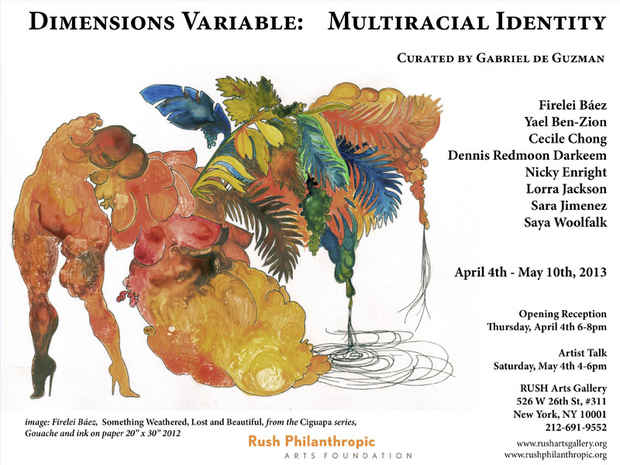"Dimensions Variable: Multiracial Identity" Exhibition
Rush Arts Gallery

This event has ended.
The 2010 census shows a 32 percent increase since 2000 of Americans who identify themselves as belonging to a multiracial background. They represent the growing multiracial diversity that has become more evident in our country and in our communities during the Obama era. Dimensions Variable: Multiracial Identity features artists whose work expresses various aspects of their diverse, yet highly individual backgrounds. The exhibition attempts to move beyond the polarized discussions of race and identity politics of the 1980s and 90s and past the limitations imposed by political correctness. It also contests the idea of a "post-racial" society presented by political commentators after the election of Barack Obama. In the four years since the biracial president's first inauguration, race has remained a critical and contentious topic in national politics. Challenging a monolithic view of race, this exhibition examines contemporary issues of identity, hybridism, and racial ambiguity. At times the artists in the show directly tackle issues that relate to race and cultural awareness. At other times, the artists deal with these issues subtly by acknowledging the spread of multiculturalism in our global society and the ways in which race and ethnicity are fluid and dependent upon perception and context.
In an effort to understand unfamiliar cultures or to foster solidarity within a community, people are frequently categorized into singular compartments according to ethnic or national origin. Current artists are looking at the political implications of racial categories and perceptions about mixing cultures. In his work, Nicky Enright explores the U.S. census, its history of ingrained prejudices, and the absurdity of categorizing one's race into insufficient and inaccurate labels; the census has only allowed respondents to indicate more than one race since 2000. Israeli-American artist Yael Ben-Zion's photographic series investigates the implications of intermarriage. Herself part of an interfaith "mixed marriage," she was appalled when she learned of the State of Israel's campaign to target Jews who were "lost" to intermarriage. She set out to photograph other couples who are facing challenges because they chose to share their lives regardless of their ethnic origins, races, or religions.
By exposing the problems of categorization, artists are opening up the dialogue about identity to make it more inclusive. Lorra Jackson's paintings explore her own multi-ethnic background of Korean and African American to engage the story of identity in the United States. Her figurative series on the platypus—an animal that was difficult for scientists to classify when it was discovered—challenges culturally-defined notions regarding race and ethnicity. Cecile Chong, who was born and raised in Ecuador of Chinese parents, creates cross-cultural narratives using subjects and materials that are appropriated from international sources. Her encaustic and multi-media works depict figures in fantastical landscapes that reflect the recurring global exchange of ideas and influences.
For these artists, personal significance and experience are portrayed in a way that is relevant to broad audiences. Dennis Redmoon Darkeem addresses the historical displacement of people of color, integrating imagery and objects from his Native American and African American cultural roots into his paintings, sculpture, and mixed-media installations. Sara Jimenez is interested in "embodied inheritance, female lineage and ancestry, and the presence of a loved figure as she exists in memory." Her drawings on nylon explore her relationship to her Filipino grandmother, Lola Meldy. Through her grandmother, Jimenez reflects on her own identity and her place in the world. As a material, the nylon represents a fragile, permeable representation of memory, as well as a second skin available in a range of hues to match one's complexion. It molds to the body and hides imperfections.
Mixed race identity can lead to a sense of feeling caught between cultures or not fitting into the communities with which one identifies. To address this disorientation, artists are exploring ideas about hybridism, ambiguity, and transmutation. Firelei Báez explores her Dominican and Haitian identity through Caribbean folklore, black female subjectivity, and aspects of her personal history. Her Ciguapa series depicts a mythological female creature that dwells in the Dominican highlands and preys on errant men. Avoiding literal representations of the Ciguapa, Báez's shape-shifting beast constantly transitions from animal to human to vegetative forms, re-conceptualizing and challenging romanticized notions of the tropics. Saya Woolfalk depicts a fictional multi-racial utopia as seen through the eyes of an anthropologist in The Ethnography of No Place series. The Empathics project depicts Woolfalk's invented race of women, a mix of ethnic identities, who progressively transform from human to plants. While each series takes a different approach—the former from the position of an outsider's observation, the latter portrayed as self-representation—they can both be seen as allegories for how conceptions of race and identity might evolve.
Through their investigations, these artists show that issues of race and identity remain complex and continually shifting in this country. By engaging this topic in new ways, their work fosters an open, inclusive, and ongoing dialogue. Recognizing that today's viewers are more culturally aware, artists challenge us to acknowledge the significance of the growing diversity in our communities.
Media
Schedule
from April 04, 2013 to May 10, 2013
Opening Reception on 2013-04-04 from 18:00 to 20:00